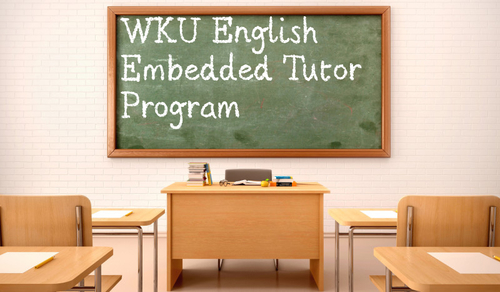Potter College News
WKU's English Department Develops Embedded Tutor Program
- Monday, August 26th, 2019

Western Kentucky University provides many options for tutoring and help in the classroom. The Embedded Tutor Program combines these concepts into a unique classroom experience. While classes are held by an instructor, an embedded tutor is available during lessons to help students, both one-on-one and as a group. The embedded tutor provides a second point of contact for the student and is able to explain lessons differently than the instructor or devote extra time to the subject for students who need it. Classes with an embedded tutor experience higher improvement levels than regular classes, benefitting the students and the class instructor.
“The Embedded Tutor Program is a win-win opportunity for everyone involved,” said Dr. Dawn Hall. “The underprepared English student receives more one-one-one assistance, the tutor works with a faculty member learning further classroom techniques which are then used to benefit students, and the faculty member has an extra set of eyes and ears to help meet the student needs. The program creates extremely valuable and empowering relationships. The embedded tutors also receive support and further pedagogical training by meeting with me twice a month in addition to the training provided by Dr. Fife in the WKU Writing Center.”
Recently, English graduate student Brian Baker started every class at the side of his instructor, Hunter Little. The slow raising of hands is often Baker’s cue to help, providing explanation and clarification when needed during the class. Mornings found him holding tutor meetings to discuss where his students need help, meeting with them one-on-one. The duality of Baker as both a student and instructor proved beneficial during his time as an embedded tutor for Little’s English 099 class.
Little commented, “My students this past semester really, really liked having Brian in the class. They liked having the same person to go back to and talk to and they benefitted from their tutor meetings. We would split up the class, and he would teach lessons to one half and I would teach the lesson to the other ones. We just got more comfortable with him.”
Familiarity and comfort when tutoring a student who may already be struggling in a subject is important, and embedded tutoring allows for a level of involvement and attention students don’t often receive in a non-assisted class. “To the students, I wasn't quite a teacher, and I wasn't quite a classmate,” said Baker. “I was somewhere in between, but something about that made me more approachable for the students.”
English graduate student Jon Meyers was an embedded tutor during the 2017 summer program. “I would start every session with setting the table and taking the temperature,” said Meyers. ”I would go one-on-one and ask ‘What are you working on?’ By the end of the meeting, we knew exactly what they needed to work on. And the following week, we would meet again and follow up on where they were. There’s a running narrative because they're not getting a new person.”
Since the program’s inception, many qualified English graduate students and a few undergraduate students have become embedded tutors, with fifteen actively embedded in the past academic year. The program offers students’ the ability to gain experience as a tutor before entering the workforce as a teacher.
“I feel very lucky to have been able to participate in the embedded tutor program,” said Baker. “It was especially valuable for me because I'll be teaching ENG 100 next semester. Being an embedded tutor allowed me to observe more teachers, more classrooms, and more students.”
For more information on the embedded tutoring program, as well as other tutoring options available, please contact Dr. Jane Fife or Dr. Dawn Hall.

